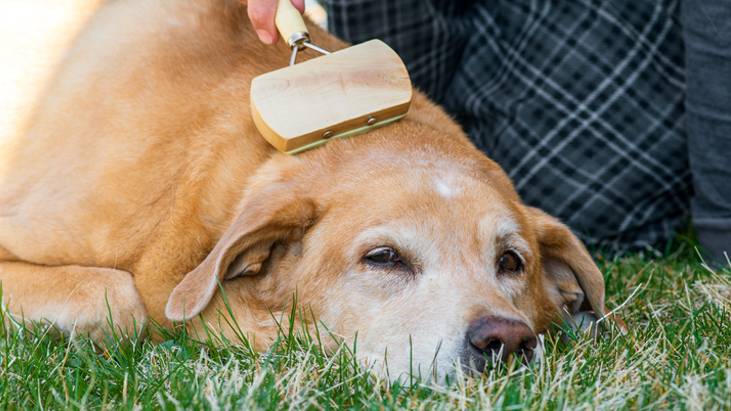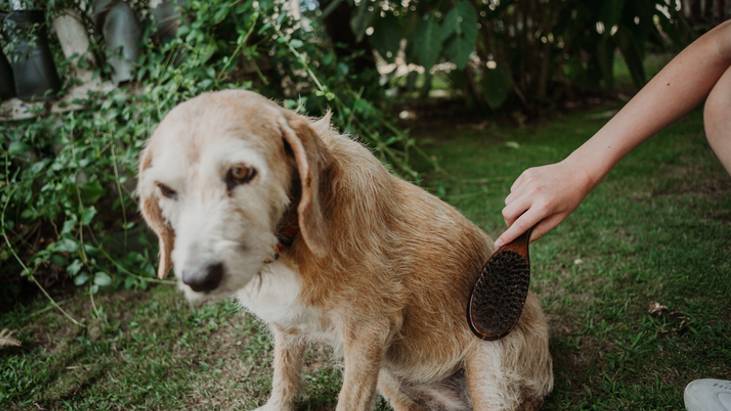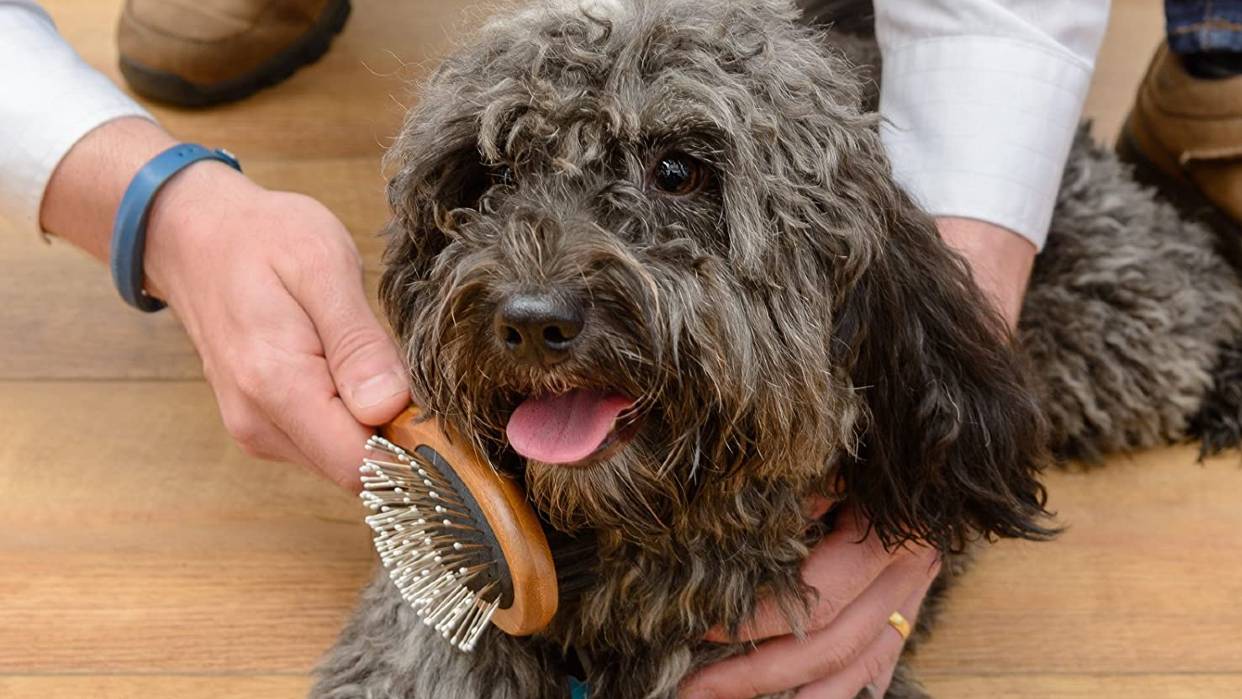A vet's guide to brushing short-haired dogs
If you’re thinking about brushing your short-haired dog, our vet has some advice for you

We all know that some dog coat types need more grooming than others, but what about brushing short-haired dogs? If you’re the owner of a short-haired dog like a Chihuahua, Labrador Retriever, or a smooth-haired Dachshund, you might be wondering how often you need to brush your dog and what type of dog brush is best for them.
From knowing how to de-shed your dog's coat to a step-by-step guide on how best to brush them, this article will help keep your pooch's hair in tip-top condition every time.
Do short-haired dogs need regular grooming?
Whilst short-haired dogs don’t need the level of grooming as many of the other coat types, it’s still a good idea to make coat care part of your dog’s routine. Cared-for coats tend to be shinier, softer, and the skin underneath is healthier. Not only that, but in caring for your dog’s coat you have the opportunity to check them over, looking for lumps and bumps, wounds, and other areas of concern. You’ll also be able to remove burrs, grass seeds, and other foreign bodies in the fur before they cause a problem.
Do short-haired dogs shed?
As any owner of a Labrador can tell you, short-haired dogs can shed, and this is especially noticeable if they have a thick coat. However, even thin-coated dogs, like Chihuahuas and Greyhounds, will shed fur – just less of it! That’s one of the reasons that brushing is important even for short-haired dogs.

How often to brush a short-haired dog
How often you should brush your short-haired dog depends on a number of factors, and it’s all about finding the right balance for you and your dog. Firstly, you need to take into account their coat thickness and type. Some dogs will have thicker fur and shed more often than others, leading you to brush them a lot more. Some dogs have sore skin, which might mean you brush less frequently. You might also want to take into account how dirty your dog gets, and how much they enjoy being brushed.
In general, aim to brush your short-haired dog about once a fortnight, or once a week if they seem to need it or particularly enjoy it. You should also brush them after a walk if they’re covered in vegetation such as grass seeds or sticky burrs. If they get muddy, you’ll also want to brush them more frequently – but wait until the mud has dried before trying to brush them!
What kind of brush is best for a short-haired dog?
For most short-haired dogs, you’ll need a bristle brush. This brush is soft on the skin, which is important as short-haired dogs often don’t have much protection from their fur. It’s great at spreading oils for a good shine, but can also pull out small knots in thicker fur. An alternative is a rubber brush, which some dogs prefer.
A de-shedding brush may also be needed, especially if you have a thick-coated, short-haired dog such as a Labrador. These dogs have a double-layered coat that can moult hairs all over your house if not kept well-groomed!
Here’s our guide to the best dog brushes if you’re in the market for a new one.

How to brush a short-haired dog
When it comes to brushing your short-haired dog, you first want to make sure your dog is comfortable. This may mean getting somebody else to hold your dog still whilst you brush them, although most dogs enjoy the process and will quickly learn to stand still (or roll on their back begging you to do their tummy!). Distractions can be helpful – a toy or static food puzzle can provide them with entertainment, especially if they’re very dirty suggesting you’ll be there a while!
Get all your brushes together, as well as your nail clippers if you’re going to check their feet whilst you’re at it.
- Start by running your hands over your dog, from head to toe. Make note of any lumps, bumps, wounds, or matted areas so you can come back to them later.
- Starting at your dog’s head end, use your bristle brush to groom over their neck and back in the direction of the hair.
- Don’t forget to focus on the neck area, as the fur here is often thicker and more prone to problems.
- If you come across any objects caught in the fur or areas of matting, leave them for now.
- You want your strokes to be firm, but not so firm that they hurt – how hard you can press will depend on your brush and your dog’s sensitivity, but watch your dog for clues that you’re going too hard.
- Your brush strokes shouldn’t be too long or too short – about a third of your dog’s back length is perfect.
- When grooming under their chest, you might ask your dog to lie on his back, or get someone to hold him vertically for you.
- You can use a comb to remove matts and dirt, but be careful of wounds or sore areas. Anything out of the ordinary is worth seeing the vet about!
How to de-shed a short-haired dog
If your dog needs a de-shed, it’s best to do this before using the bristle brush, as the bristle brush will remove any loose hairs you missed. The de-shedding brush is designed to get down to the undercoat, which is very dense and will be responsible for most of the hairs around your house.
Similar to general brushing, it’s a good idea to start de-shedding your dog at the head end, then brush in the direction of the fur. Again, you’ll need your brush strokes to be firm to get through the upper layers of fur, so watch your dog to check you aren’t pressing too hard. You’ll generally come away with a brush full of fur after each stroke, especially at certain times of year – you should empty this before continuing.
Once you’ve finished de-shedding, use a bristle brush or a rubber brush to grip and gently pull on any remaining loose hairs, as well as spread the skin oils over the fur for a nice shine.

Final thoughts
Thin-coated short-haired dogs need very little coat care, but you’ll probably find that brushing your short-haired dog is still fun for both of you and can be an important bonding experience. Short-haired dogs with thicker coats may need more frequent and more thorough brushing and may need de-shedding, too. If you find any wounds or lumps whilst brushing your dog, don’t forget to book an appointment with your vet to get them checked out.
PetsRadar Newsletter
Get the best advice, tips and top tech for your beloved Pets
After graduating as a vet from the University of Nottingham, Dr Joanna Woodnutt went on to practice companion animal medicine in the Midlands. Since then, she has also written for countless online and print publications and is a regular contributor for Edition Dog Magazine.

